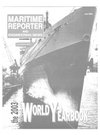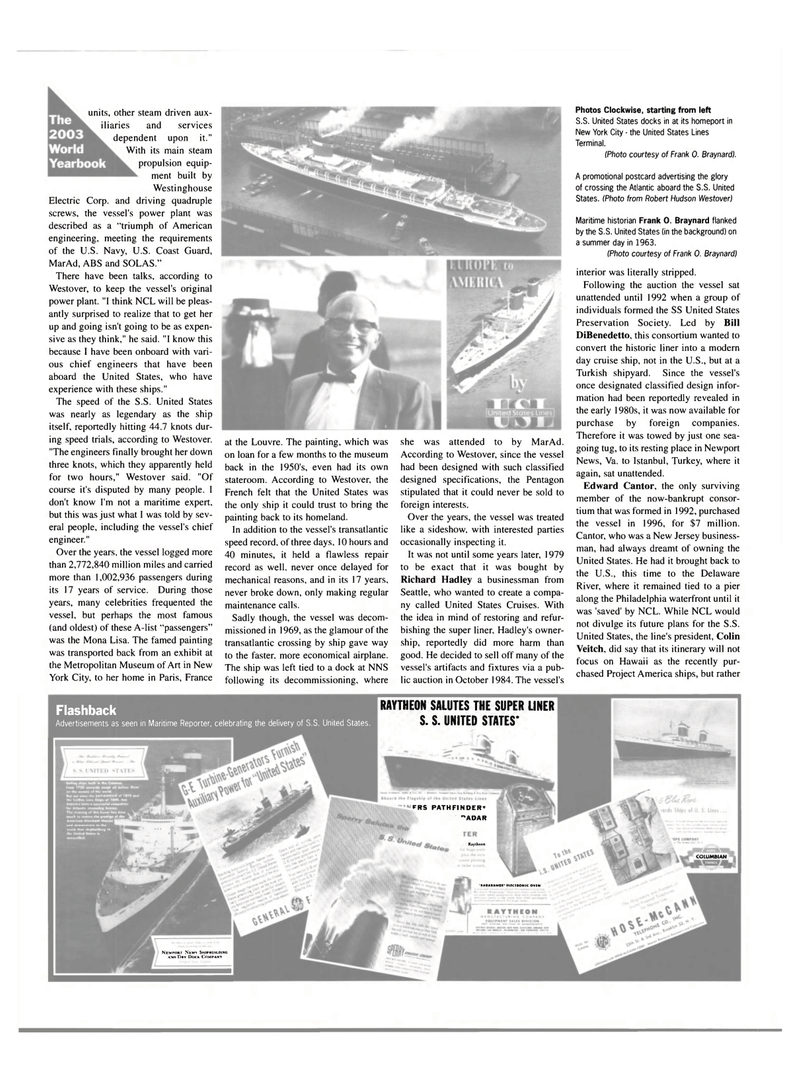
Page 38: of Maritime Reporter Magazine (June 2003)
Read this page in Pdf, Flash or Html5 edition of June 2003 Maritime Reporter Magazine
Photos Clockwise, starting from left
S.S. United States docks in at its homeport in
New York City - the United States Lines
Terminal. (Photo courtesy of Frank 0. Braynard).
A promotional postcard advertising the glory of crossing the Atlantic aboard the S.S. United
States. (Photo from Robert Hudson Westover)
Maritime historian Frank 0. Braynard flanked by the S.S. United States (in the background) on a summer day in 1963. (Photo courtesy of Frank 0. Braynard) interior was literally stripped.
Following the auction the vessel sat unattended until 1992 when a group of individuals formed the SS United States
Preservation Society. Led by Bill
DiBenedetto, this consortium wanted to convert the historic liner into a modern day cruise ship, not in the U.S., but at a
Turkish shipyard. Since the vessel's once designated classified design infor- mation had been reportedly revealed in the early 1980s, it was now available for purchase by foreign companies.
Therefore it was towed by just one sea- going tug, to its resting place in Newport
News, Va. to Istanbul, Turkey, where it again, sat unattended.
Edward Cantor, the only surviving member of the now-bankrupt consor- tium that was formed in 1992, purchased the vessel in 1996, for $7 million.
Cantor, who was a New Jersey business- man, had always dreamt of owning the
United States. He had it brought back to the U.S., this time to the Delaware
River, where it remained tied to a pier along the Philadelphia waterfront until it was 'saved' by NCL. While NCL would not divulge its future plans for the S.S.
United States, the line's president, Colin
Veitch, did say that its itinerary will not focus on Hawaii as the recently pur- chased Project America ships, but rather units, other steam driven aux- iliaries and services dependent upon it."
With its main steam propulsion equip- ment built by
Westinghouse
Electric Corp. and driving quadruple screws, the vessel's power plant was described as a "triumph of American engineering, meeting the requirements of the U.S. Navy, U.S. Coast Guard,
MarAd, ABS and SOLAS."
There have been talks, according to
Westover, to keep the vessel's original power plant. "I think NCL will be pleas- antly surprised to realize that to get her up and going isn't going to be as expen- sive as they think," he said. "I know this because I have been onboard with vari- ous chief engineers that have been aboard the United States, who have experience with these ships."
The speed of the S.S. United States was nearly as legendary as the ship itself, reportedly hitting 44.7 knots dur- ing speed trials, according to Westover. "The engineers finally brought her down three knots, which they apparently held for two hours," Westover said. "Of course it's disputed by many people. I don't know I'm not a maritime expert, but this was just what I was told by sev- eral people, including the vessel's chief engineer."
Over the years, the vessel logged more than 2,772,840 million miles and carried more than 1,002,936 passengers during its 17 years of service. During those years, many celebrities frequented the vessel, but perhaps the most famous (and oldest) of these A-list "passengers" was the Mona Lisa. The famed painting was transported back from an exhibit at the Metropolitan Museum of Art in New
York City, to her home in Paris, France at the Louvre. The painting, which was on loan for a few months to the museum back in the 1950's, even had its own stateroom. According to Westover, the
French felt that the United States was the only ship it could trust to bring the painting back to its homeland.
In addition to the vessel's transatlantic speed record, of three days. 10 hours and 40 minutes, it held a flawless repair record as well, never once delayed for mechanical reasons, and in its 17 years, never broke down, only making regular maintenance calls.
Sadly though, the vessel was decom- missioned in 1969, as the glamour of the transatlantic crossing by ship gave way to the faster, more economical airplane.
The ship was left tied to a dock at NNS following its decommissioning, where she was attended to by MarAd.
According to Westover, since the vessel had been designed with such classified designed specifications, the Pentagon stipulated that it could never be sold to foreign interests.
Over the years, the vessel was treated like a sideshow, with interested parties occasionally inspecting it.
It was not until some years later, 1979 to be exact that it was bought by
Richard Hadley a businessman from
Seattle, who wanted to create a compa- ny called United States Cruises. With the idea in mind of restoring and refur- bishing the super liner, Hadley's owner- ship, reportedly did more harm than good. He decided to sell off many of the vessel's artifacts and fixtures via a pub- lic auction in October 1984. The vessel's
RAYTHEON SALUTES THE SUPER LINER
S. S. UNITED STATES* fRS PATH FINDER* "ADAR
Raytheon
CQiUMSIAN •RADABANGl- ELECTRONIC OVEN
NEWPORT NEWS SHIPBUILDING
AND DRY DOCK COMPANY
Flashback
Advertisements as seen in Maritime Reporter, celebrating the delivery of S.S. United States.

 37
37

 39
39
